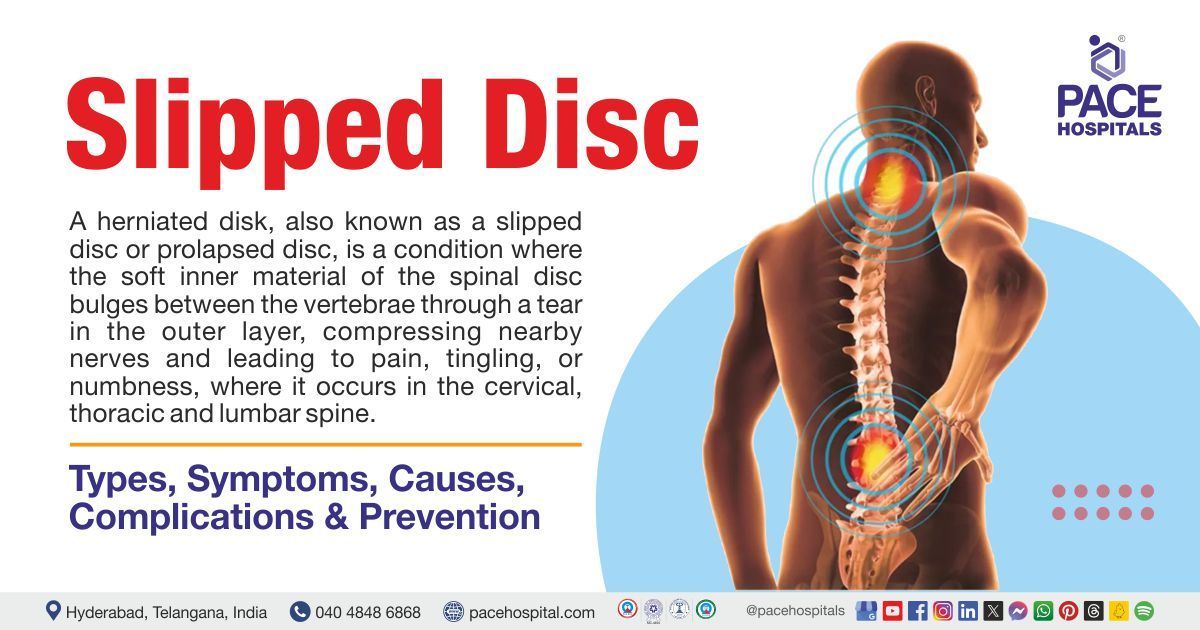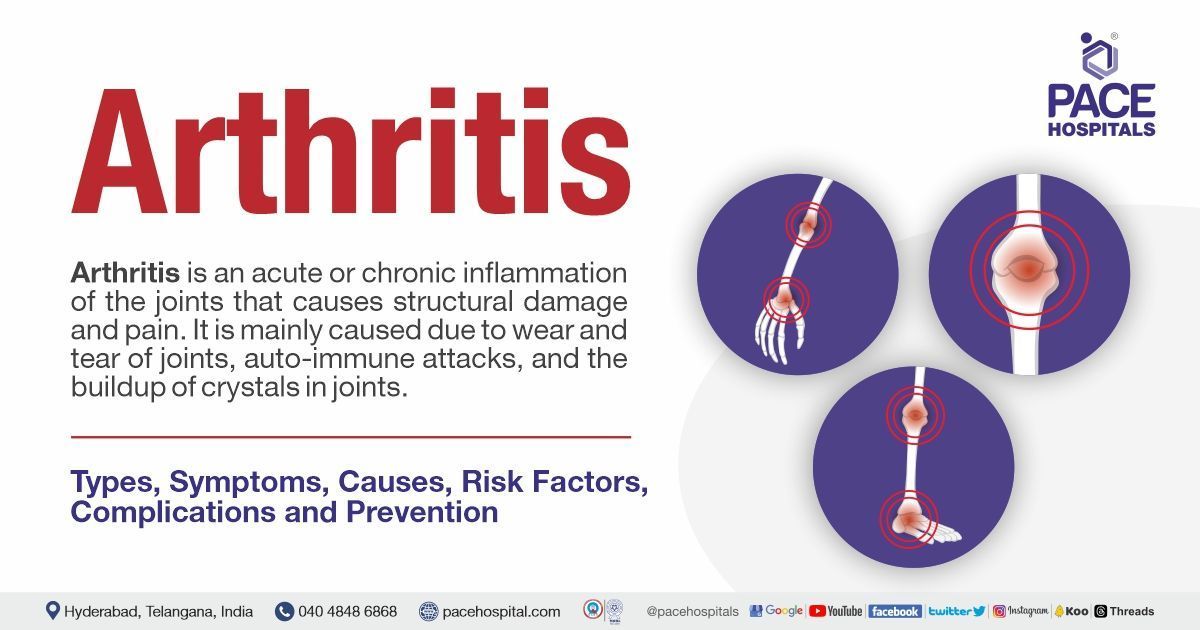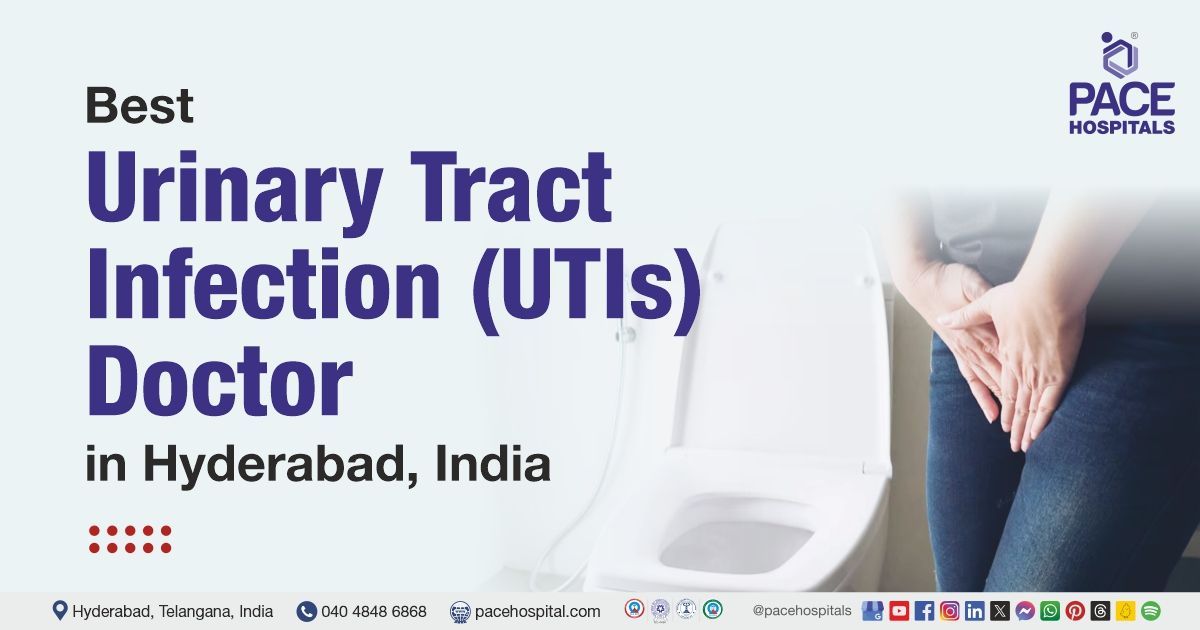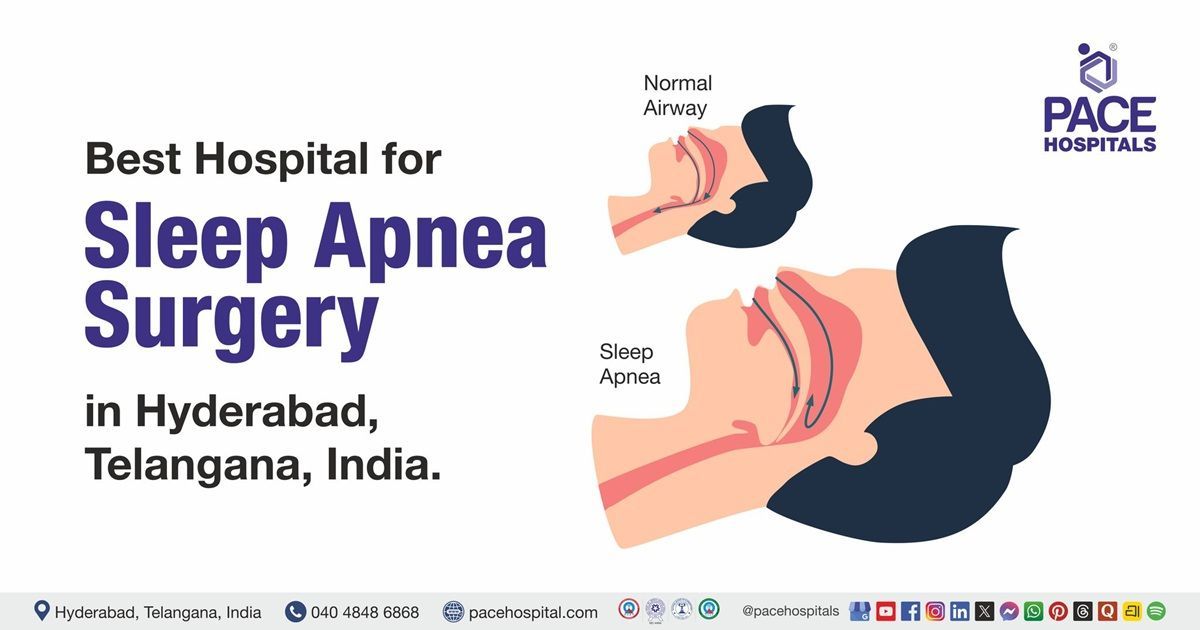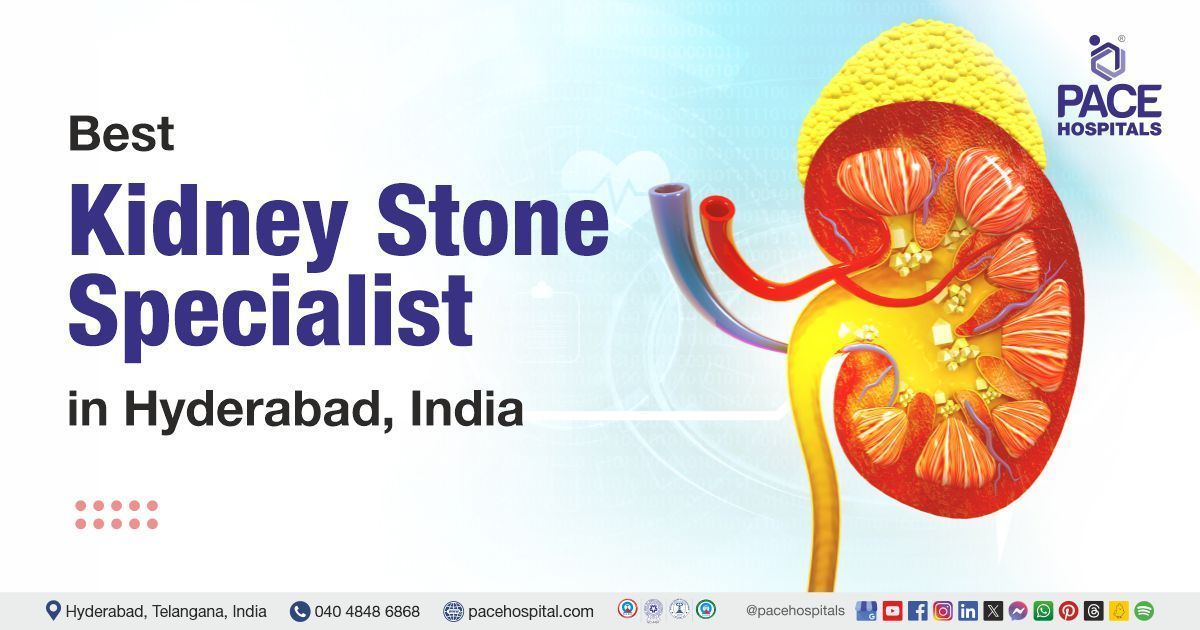Slipped Disc (Herniated disc) - Symptoms, Causes, Risk Factors, Complications, Prevention
Slip disc meaning
A slipped disc also known as a herniated disc or prolapsed disc, is a condition where the soft inner material of the spinal disc bulges between the vertebrae through a tear in the outer layer, compressing nearby nerves and leading to pain, tingling, or numbness, where it occurs in the cervical, thoracic and lumbar spine.
A slipped disc is also called as spinal disc prolapse, slip disc, disc bulge, prolapsed intervertebral disc, ruptured, bulging, protruding disc. Slip disc problem often indicates injury of the spine.
Slipped disc anatomy
The human lumbar spine consists of the spinal cord, vertebrae (bones), muscles, ligaments, cartilage, and nerves. Each of these structures plays a crucial role in the form and function of the lumbar spine. A spine comprises vertebrae and intervertebral discs, which run from the bottom of the skull to the tailbone forming backbone, which supports the body and protects the spinal cord.
The human spine has four regions: neck (cervical), upper back (thoracic), lower back (lumbar), pelvis (sacral), and is made of 33 bones (vertebrae) that are arranged one on top of the other to form the spinal column. They are the building blocks supported by different muscles and ligaments to protect the spinal cord and nerves. These parts are divided as follows:
- Cervical spine: The first seven vertebrae, situated in the neck.
- Thoracic spine: Next twelve vertebrae, situated in the chest area.
- Lumbar spine: The next five vertebrae, situated in the lower back.
- Sacral spine: The lowest five vertebrae, situated below the waist, also includes the four vertebrae that make up the coccyx (tailbone)
The spinal column supports standing, bends, and twists, protects itself from injury, and consists of strong muscles, bones (vertebrae), flexible tendons, ligaments, and sensitive nerves. The first 24 bones are moveable, but the sacrum and coccyx vertebrae are fused. These 33 vertebrae are separated by spongy discs. These discs, also known as intervertebral discs, are made up of a jelly-like substance and give flexibility by acting as cushions and shock absorbers.
An intervertebral disc is a cartilaginous structure consisting of 3 parts: a gel-like nucleus (inner nucleus pulposus), a tough outer ring (outer annulus fibrosus), and endplates connecting discs to nearby vertebrae.
When the soft gel-like nucleus (inner nucleus pulposus) pushes through the annulus fibrosus (outer ring), it is called herniation. Herniations can occur either gradually or suddenly, potentially leading to symptoms such as back pain and nerve irritation.
Prevalence of Slipped disc
Slipped disc prevalence is the most common, even in healthy people. Up to 20% of young adults and over 75% of older adults have spinal disc herniations, often without experiencing any issues. Each year, up to 2% of people suffer from a herniated disc, which may cause pain in the neck, arms, back, or legs.
Prevalence of cervical disc herniation
The incidence of cervical disc herniation rises with age for both men and women and most commonly occurs in women (60%) and people in their 3rd to 5th decades of life.
Prevalence of thoracic disc herniation
Intervertebral disc herniation in the thoracic region is uncommon, occurring in only 0.5% to 4.5% of all disc ruptures. Also, it is rare to cause noticeable symptoms, accounting for only 0.25% to 0.75% of cases.
Regarding surgeries specifically for disc herniation, cases in the thoracic area are relatively rare compared to other areas of the spine, such as cervical and lumbar, accounting for only about 0.15% to 1.8% of cases and most commonly affects people between 40 and 60 years old.
Prevalence of lumbar disc herniation
Prevalence of lumbar disc herniation is relatively common, with 5 to 20 cases per 1000 adults yearly, and it is most common in the third and fifth decade of life, with a 2:1 ratio (male to female ratio). The estimated occurrence of symptomatic herniated discs of the lumbar spine ranges from 1-3% among patients.
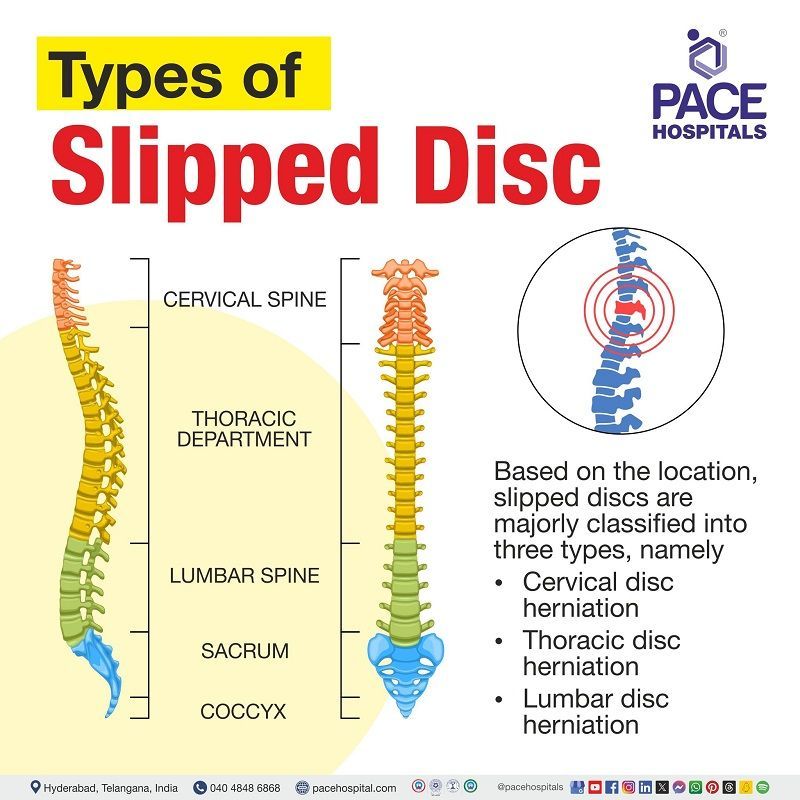
Types of Slip disc
Types of slip discs (disc herniation) are divided based on severity and location, which includes:
- Disc prolapse
- Disc extrusion
- Disc sequestration
Disc prolapse: The disc bulges out between the vertebrae, but its outermost layer remains like a ballon without burst.
Disc extrusion: There is a tear in the disc's outermost layer, and some of the disc material may leak out. However, this tissue material is still connected to the disc.
Disc sequestration: Disc material has left the disc, moved into the spinal canal, and is no longer attached to the main disc.
Based on the location, herniated discs are majorly classified into three types, namely
- Cervical disc herniation
- Thoracic disc herniation
- Lumbar disc herniation
Disc herniation is common in the cervical, thoracic, and lumbar regions of the spine but rare in the sacral and coccyx due to anatomical differences.
Cervical disc herniation
It is also called cervical disc prolapse. The cervical spine has seven vertebral bones, numbered C1 to C7, counting from the end of the skull to the thoracic spine. It typically occurs between C5-C6 and C6-C7 and may cause symptoms at C6 and C7, respectively. It happens when the inner part of a spinal disc in the cervical area (neck) moves out of place, potentially pinching nearby nerve roots or pressing directly on the spinal cord. It is a common cause of neck pain in adults, and severity ranges from mild to severe and even serious.
This may cause radiculopathy, a condition characterized by inflammation (swelling) and compression of the nerves near the cervical spine, resulting in symptoms such as tingling, pain, or weakness in the affected site.
Thoracic disc herniation
The thoracic spine has 12 vertebrae (T1 to T12) in the upper and mid-back. It is attached to a rib on either side, which is larger and stronger than the cervical vertebrae and provides significant strength and stiffness to the thoracic section of the spine.
Thoracic disc herniation is rare compared to lumbar and cervical disc herniation and mainly occurs between T8 and L1. However, it is a treatable spinal condition in which the soft center gel-like nucleus of a thoracic intervertebral disc (nucleus pulposus) pushes through a tear in the tough outer layer of the disc (annulus fibrosus) and into the spinal canal and may put pressure on the thoracic part of the spine and spinal cord causing symptoms.
Lumbar disc herniation
It is also called a lumbar disc prolapse. The Lumbar spine consists of five (L1-L5) vertebrae and intervertebral discs; a herniated lumbar disc refers to a change in a spinal disc of the lower back. It occurs due to the tear in the annulus fibrosus, allowing the sections of its nucleus pulposus (inner layer) to leak through the tear.
Symptoms and severity may vary depending on the location of the disc and affected nerves. The terms prolapse, extrusion, and sequestration are critical in choosing the appropriate treatment and predicting the condition's progression. Healthcare professionals may choose better treatment plans and predict symptoms or complications by understanding the type of slipped disc.
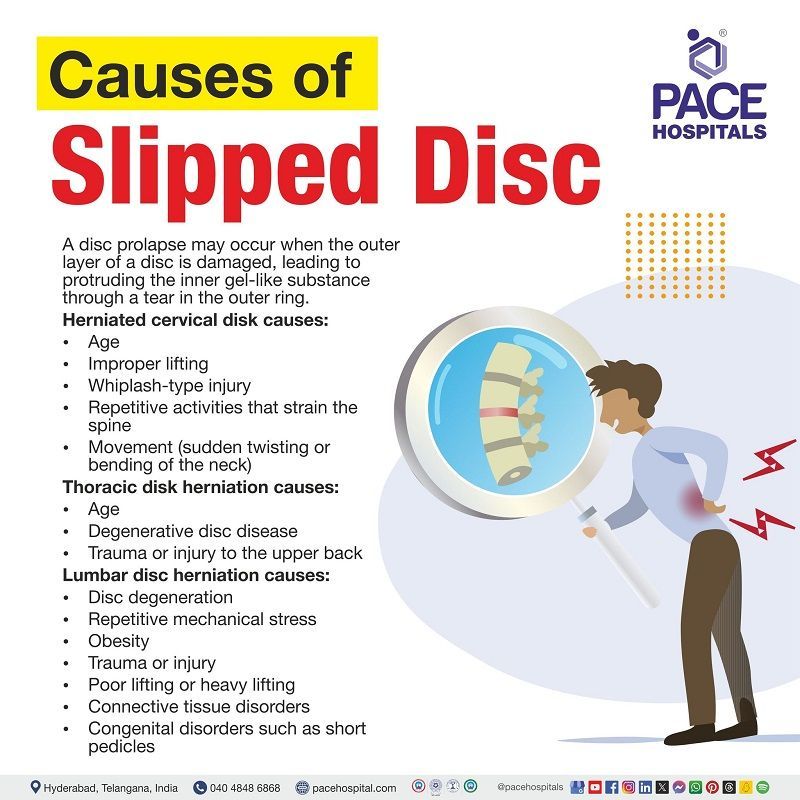
Slip disc causes
Slipped discs may result due to factors such as age-related disc degeneration, spine injury, or trauma, which causes the gel-like center of the intervertebral disc to protrude or rupture through its outer layer. The following are the most frequent reasons for experiencing a slipped disc:
Cervical disc herniation causes
The cervical spine has smaller discs with high mobility; due to this, they are more prone to degeneration (wear and tear) from sudden forces and repetitive movements where the disc herniation is mainly caused by a gel-like center (nuclear pulposus extrusion) pushing through the outer ring (annulus fibrosus).
Other cervical slipped disc causes include the following:
- Improper lifting
- Whiplash-type injury
- Repetitive activities that strain the spine
- Movement (sudden twisting or bending of the neck)
Thoracic disc herniation causes
It has larger discs than a cervical region and less mobility due to the presence of ribs that are less prone to herniation. Hence, disc herniation is rare. However, they are more susceptible to developing complications if they occur. A thoracic disc herniation occurs when the discs between the spine may tear slightly without fully bulging out (coming out of place). This may occur due to an existing health problem or significant injury.
Thoracic disc herniation causes include the following:
- Degenerative disc disease
- Trauma or injury to the upper back
Lumbar disc herniation causes
It has the largest discs, which bear the most weight, and has high-risk herniation due to progressive stress and poor posture. Lumbar disc disease may happen when an intervertebral disc in the lower back area of the spine herniates or bulges from between the bony area of the spine.
Causes of lumbar disc prolapse include the following:
- Disc degeneration
- Repetitive mechanical stress
- Obesity
- Trauma or injury
- Poor lifting or heavy lifting
- Connective tissue disorders
- Congenital disorders
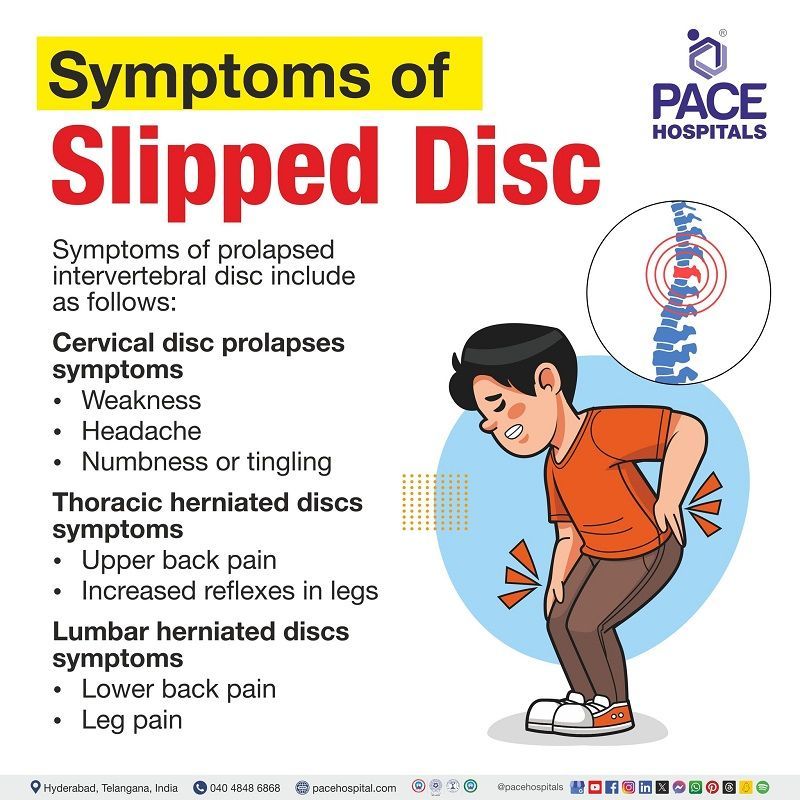
Slipped disc symptoms
The symptoms of a slipped disc may vary significantly based on the size and position of the herniation (herniated disc). Symptoms arise when a slipped disc puts pressure on a nearby nerve. The following are the symptoms commonly seen in patients with slipped discs:
Cervical herniated disc symptoms
Other cervical herniated disc symptoms often include neck pain that radiates down to the arm fingers (radiculopathy). Other slipped cervical disc symptoms includes:
If the disc puts pressure on a nerve root, symptoms include:
- Weakness
- Headache
- Numbness or tingling
If it presses on the spinal cord, the patient has more severe symptoms, such as:
- Loss of balance and coordination
- Stumbling or awkward walking
- Motor weakness
Thoracic herniated disc symptoms
It rarely compresses nerves because of limited mobility and may cause localized pain, discomfort, burning sensations, or even difficulty breathing if it affects specific nerves. Thoracic herniated disc symptoms often include the following:
- Upper back pain
- Hyperreflexia (overresponsive or overactive bodily reflexes to stimuli) and spasticity (muscle stiffness)
- Bowel and bladder dysfunction
- Stubborn intercostal neuralgia (persistent pain along the nerves between ribs) or neurological deficits (impairments in function of nervous system)
- Numbness or tingling
- Muscle weakness
- Increased reflexes in legs
Lumbar herniated disc symptoms
Lumbar herniation often puts pressure on the sciatic nerve, which may lead to the condition classic sciatica with radiating pain down the leg, leg numbness, or weakness. Lumbar disc herniation symptoms often include the following:
- Lower back pain
- Sciatica (Pain along one or both legs due to sciatic nerve compression)
- Leg pain
- Nerve pain
- Neurological symptoms
- Limited truck flexion
Risk Factors of Slip Disc
The following are the risk factors for slipped disc development in the cervical, thoracic and lumbar regions:
Cervical disc herniation risk factors
Common risk factors for developing cervical disc herniation includes:
- Age
- Congenital abnormalities in the spinal canal
- Occupational factors
- Cervical spinal trauma
- Lack of regular exercise
- Tobacco use
- Poor posture (i.e., incorrect lifting or twisting causing additional stress on the cervical spine),
- Inadequate nutrition
- Poor lifestyle
Thoracic disc herniation risk factors
Common risk factors for developing thoracic disc herniation includes:
- Age
- Diseases of the thoracic spine
- Scheuermann's disease (abnormal rounding of the upper back vertebrae in adults)
- Being overweight
- Poor posture
- Joint stiffness
- A sedentary lifestyle
Lumbar disc herniation risk factors
The following are the common risk factors for developing lumbar disc herniation:
- Age
- Elevated BMI
- Other conditions
- Family history
- Sudden twisting or bending
- Frequent driving
- Weight-bearing sports
- Smoking
- Sedentary lifestyle
Risk factor for reoccurrence
- Minor disc degeneration
- Previous herniation type and level
Complications of Slipped disc
Complications arising from cervical, thoracic, and lumbar disc herniations may vary due to the individual structures and functions of these spinal regions, the possible complications of slipped disc may include as follows:
Cervical disc herniation complications
The following are the complications of cervical disc herniation:
- Myelopathy (spinal cord dysfunction)
- Radiculopathy (nerve pain caused by pinching of nerves at the root)
- Autonomic dysfunction (abnormal or impaired functioning of autonomic nervous system)
- Hyperreflexia (overresponsive or overactive bodily reflexes to stimuli)
- Hypertrophy of ligamentum flavum: Abnormal thickening of the ligamentum flavum, associated with spinal canal stenosis (Cervical stenosis: Narrowed spinal canal)
Thoracic disc herniation complications
The following are the complications of thoracic disc herniation:
- Complete paralysis below the waist
- Damage to the nerves in the lower body and legs
- Spinal cord injury
- Cerebrospinal fluid leak
Lumbar disc herniation complications
The following are the complications of lumbar disc herniation:
- Chronic back pain
- Leg numbness or weakness
- Cauda equina syndrome (severe nerve compression)
Slipped disc diagnosis
Diagnosis of slipped disc for cervical, thoracic, and lumbar disc herniations may involve several approaches, which include:
Cervical disc herniation diagnosis
Diagnosis of cervical disc herniation mainly involves physical examination, which involves the detection of pain with neck movement, reduced reflexes, muscle weakness etc., other examinations includes:
- History
- C-reactive protein (CRP)
- Erythrocyte sedimentation rate (ESR)
- Complete blood count
- Discography
- X-ray
- Computed tomography scan (CT scan)
- Myelogram
- Magnetic resonance imaging (MRI) imaging
- Electromyogram and nerve conduction studies (EMG/NCS)
Thoracic disc herniation diagnosis
Diagnosing thoracic disc herniations is tricky due to the resemblance of other medical conditions symptoms such as lung, heart, stomach, or urinary problems rather than typical neck or back pain. Unlike lumbar or cervical problems that frequently cause leg or arm pain, thoracic disc herniations may have vague symptoms, making them hard to detect. In some cases, lateral herniation around C7-T1 or T1-2 can cause Horner's syndrome, with specific eye and facial symptoms.
Hence, diagnosis mainly involves imaging studies such as MRI or CT myelography, and other tests include the following:
- History
- Physical examination
- X-rays
Lumbar disc herniation diagnosis
Lumbar disc herniation diagnosis mainly involves a physical examination to check the limited range of motion, X-rays for disc space narrowing, and MRI for nerve involvement. Other tests include the following:
- The straight leg raise test (positive SLR test for sciatica)
- The contralateral (crossed) straight leg raise test
- Electromyography (EMG)
Slipped disc treatment
The slipped disc treatment options for cervical, thoracic, and lumbar disc herniations may include the following:
- Conservative treatments (non-surgical treatment)
- Interventional treatments
- Surgical treatment (herniated disc surgery)
Cervical disc herniation treatment
The following are the treatment options for cervical disc herniation:
Conservative treatments (non-surgical treatment)
Most of the cases may resolve on their own within several weeks without treatment. However, conservative treatments may be initiated if the symptoms remain persistent
- Rest
- Medicines
- NSAID's
- Collar immobilization
- Physical therapy
- Cervical manipulation
- Cold and heat
- Traction
Interventional treatments
- Spinal steroid injections
- Neuromodulatory techniques
Surgical treatment
- Anterior cervical discectomy and fusion (ACDF)
- Posterior cervical laminoforaminotomy
- Total disc replacement
- Cervical corpectomy and fusion
Thoracic disc herniation treatment
The following are the different treatment approaches for thoracic disc herniation:
Conservative treatment
One of the treatment options for this condition is conservative management, which involves strengthening through extension exercises and others such as:
- Observation
- Rest
- Medications
- Pain medications: Narcotic and non-narcotic analgesic medications
- Chiropractic manipulation
- Physical activity
Interventional treatments
- Anti-inflammatory injections: Epidural steroid injection (ESI)
Surgical treatment
- Laminotomy and discectomy
- Microdiscectomy
- Costotransversectomy
- Transthoracic decompression
- Thoracic fusion
- Video-assisted thoracoscopy surgery (VATS)
Lumbar disc herniation treatment
The following are the various treatment approaches for lumbar disc herniation:
Conservative treatments
- Rest (Bed rest)
- Pain medications
- Spinal manipulation
- Physical therapy
Minimally invasive treatments
- Epidural steroid injections
- Coblation nucleoplasty
- Pulsed radiofrequency of the dorsal root ganglion
- Spinal cord stimulation
Surgical treatments
- Laminotomy and Discectomy:
- Discectomy
- Microdiscectomy
- Endoscopic discectomy
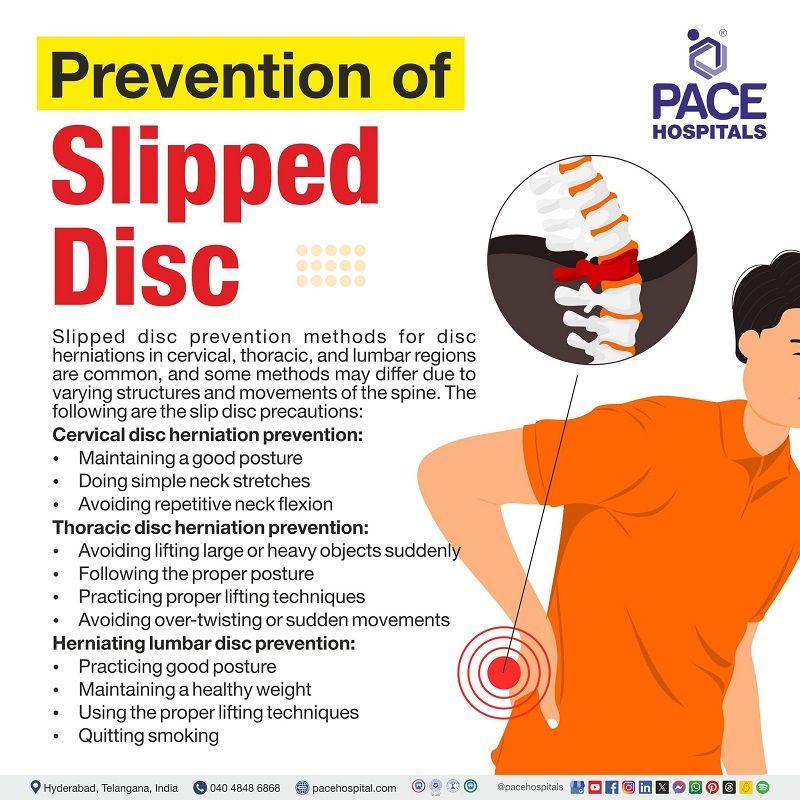
Slipped disc prevention
Slipped disc prevention methods for cervical, thoracic, and lumbar regions are common, and some methods may differ due to varying structures and movements of the spine. The following are the slip disc precautions:
Cervical disc herniation prevention
The following are some preventive measures that one may take to avoid cervical disc herniation:
- Maintaining a good posture while playing sports or generally standing, sitting, and sleeping
- Practicing neck exercises such as shoulder stretch, chin tucks, etc., to improve flexibility and strengthen the muscles around the neck
- Do simple neck stretches while sitting or standing in the same position for a long time
- Avoid repetitive neck flexion
- Managing weight to reduce the strain
- Eating green and leafy veggies, nuts, oily fish, and other foods to fight inflammation
Thoracic disc herniation prevention
- Managing weight
- Avoiding lifting large or heavy objects suddenly
- Exercising and following the proper posture and do the exercises that support the upper back muscles to promote thoracic spine flexibility and mobility
- Avoiding prolonged sitting, over-twisting or sudden movements that could strain the mid-back region
Lumbar disc herniation prevention
- Practicing good posture
- Maintaining a healthy weight
- Using the proper lifting techniques
- Quitting the smoking
- Performing the core exercises to improve core strength
- Staying active
Difference between bulging disc and herniated disc
Bulging disc vs herniated disc
As mentioned above, bulging, herniated, and slipped discs may refer to one condition; often, these words are used interchangeably. However, there is a slight difference between these conditions, which include:
| Elements | Bulging disc | Herniated disc |
|---|---|---|
| How it occurs | A bulging disc occurs when it bulges beyond its normal boundary without causing rupture to its outer layer or causing some crack. | It occurs when the outer layer becomes thin and stretched out. A large amount of inner material comes out and migrates into the spinal canal. |
| Damage | Mostly, In the case of a bulging disc, the outer remains undamaged. | In this condition, the outer layer may be torn or damaged. |
| Symptoms | Occasionally, bulging discs cause symptoms. | Herniated discs are more potential to cause symptoms because there is more protrusion of disc material. |
| Severity | It may cause little or no discomfort | It is more likely to be painful because it usually protrudes more and irritates nearby nerve roots. |
| Medications | Over-the-counter medications may help relieve pain and inflammation. | Prescribed pain medications will help relieve pain and inflammation. |
| Surgery | These discs do not usually need surgery. | These discs may require surgery to fix the damage. |
| Prognosis | Generally, it has a good progress with non-surgical treatment. | Progression may differ from person to person and depend on overall health condition. However, surgery will be needed in some cases. |
FAQs - Frequently Asked Questions on Slipped disc (Herniated disc)
Why does a slip disc happen?
A slipped disc may happen when the outer ring weakens or ruptures, allowing the inner portion to move out. This might mainly occur due to age because as a person ages, discs start to lose their protective water content, leading to slipped discs, and certain motions, such as sudden movements like twisting or turning and lifting a heavy and oversized object, may place increased strain on the spine, resulting in a slipped or herniated disc.
How to get a slipped disc back in place?
Most cases with a slipped or herniated disc in the lumbar region of the spine (lower back) are offered conservative treatment to promote healing and alleviate symptoms. That mainly involves relaxing, exercising and positioning, using pain medications or local anaesthetics, and manual and physical therapy.
is a slipped disc permanent?
No, slipped discs are not permanent and usually resolve on their own; many cases improve on their own within six weeks to three months without treatment. However, conservative treatments such as pain medications, physical therapy, and sometimes surgery in severe cases may help to promote healing and reduce the pain.
Can slip disc cause paralysis?
Yes, a severely slipped disc or prolapsed disc may cause paralysis in rare cases due to compression or irritation of disc material on the nearby nerves or spinal cord, leading to weakness, numbness, and rarely paralysis in the arms or legs. However, this is very rare, and most people with slipped or herniated discs may experience pain and discomfort rather than paralysis.
Can slip disc affect pregnancy?
No, a slipped disc cannot affect pregnancy, but a pregnant woman may find an increase in lower back pain; a mild to moderately slipped disc might not affect pregnancy and the baby's health. However, more severe cases may require conservative treatment such as pain medication, bed rest, physical therapy, and rehabilitation. Surgery is rarely needed.
Is walking good for a herniated disc?
Yes, gentle exercises such as stretches, walking, and cycling are suitable for people with disc herniation because they reduce the symptoms by promoting blood flow, maintaining flexibility, and strengthening muscles without excessive strain on the spine. These gentle exercises may also prevent the herniated disc from recurring. A Neurologist may recommend specific slipped disc exercises based on the type.
What kind of pain does a slipped disc cause?
Pain may occur as localized or radiating pain which begins at one side of the body and radiate to other parts; it is associated with a tingling sensation, numbness, and weakness in the affected parts such as the neck, buttocks, legs, or feet and feels like sharp or shooting pain in one part, and often becomes worse with certain movements.
Share on
Request an appointment
Fill in the appointment form or call us instantly to book a confirmed appointment with our super specialist at 04048486868

